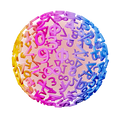Derivation of Distance to Get Velocity and Acceleration
Derivatives reveal a new connection between distance , velocity and acceleration . By differentiating, you can find an expression for velocity and acceleration using the provided distance . This is how they are connected:
Rule
Distance, Velocity and Acceleration
If you have the position (distance) , then it follows that
Example 1
A plane flies from London to New York. The aircraft’s position above the Atlantic is given by
- 1.
- How far has the plane flown after four hours?
- 2.
- What is the velocity of the plane after four hours?
- 3.
- Find the acceleration of the plane after four hours.
- 1.
- You insert into : After four hours, the plane has flown km.
- 2.
- To find the velocity of the plane after four hours, you have to find the velocity of the plane. You find that by differentiating : After four hours, the velocity of the plane is about km/h.
- 3.
- To find out what the acceleration is after four hours, you have to differentiate the velocity function . That gives you
After four hours, the acceleration of the plane is km/h2. This tells you that the plane is increasing its speed four hours into the flight.

AI
How can I help you?
Beta




















